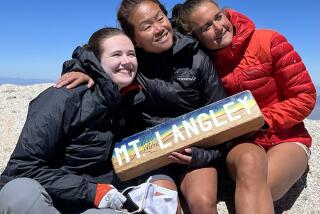Tiny Paws That Will Lead and Protect
- Share via
The first class of puppies to fall around the obstacle course was the babies, puppies 4 to 7 months old. They had the invincible innocence of all young things, and they lumbered around the course on their big, round feet, soft as muffins.
This was last Sunday at the open house of International Guiding Eyes in Sylmar in the San Fernando Valley. My friend Mary Ann Thomas is president of the California State Board of Guide Dogs for the Blind. Mary Ann knows I will go anywhere I can meet a lot of dogs, and there were a lot there, all enchanting.
The obstacle course was laid out on a lawn between a couple of International Guiding Eyes’ buildings. The first thing the pups had to do was sit; all of them managed that. Several gave the tester-trainer warm kisses on his hand.
The first problem the dogs encountered was food, two large, unopened sacks of dried food, and balanced on top a plate holding two hamburger patties and two grilled frankfurters. The purpose was to test the dogs’ distractibility. A dog guiding a blind person must ignore temptations, even hamburgers.
Another trial was a set of steps built like a stile, three steps up, a small platform, then three steps down. There was a handrail on each side for the handlers, the people who have taken the pups into their homes to raise until they are 1 year old. The steps sound easy--but almost all of the puppies spread their hind legs and braced themselves as if for a tug of war. The dogs between 7 and 11 months old did much better, although several of those had to be hauled up the stairs by their handlers with the help of the tester-trainer. The older dogs walked up the steps, posed and gazed grandly at the crowd from the top, and walked with a casual Chesterfieldian air down the other side.
A few feet away was a wire pen holding two Rhode Island red chickens borrowed from Knott’s Berry Farm for the day, another test of the dogs’ ability to keep their minds on their work. A few of the dogs walked right by. The tester made sure they went back and looked at the chickens. Some of the dogs, very few, shrugged. “Big deal. A couple of chickens.”
A lot of them jumped back in surprise and then approached the pen and sniffed at the chickens. A couple were obviously uneasy about the chickens, even afraid, and got away as soon as possible.
The next test was a grill placed flat on the grass, like a grid or a manhole cover such as dogs might encounter when they graduated and had their own people to guide. Some of the dogs trotted casually across it, some sniffed it and then went over it, but several tried to walk on their tiptoes in the front while kicking their hind feet up as fast as they could.
The last obstacle was a large floor fan, turned on, with crepe paper streamers blowing out from it. Again, some dogs merely looked and walked ahead, some were hesitant and one large German shepherd was not going to go by it at all. At first he tried to walk on the side away from the infernal thing, but the trainer made him come back and walk between his friend and the fan.
Only one dog broke the pattern at the plate of grilled meats. He grabbed a frankfurter and happily chomped it. He was so quick, his handler didn’t have time to pull him back. One snap and he had it. Everyone laughed and I clapped. Oh, just a little bit. But I am on the side of the fellow who says, “Oh, come on, let’s give it a go.”
International Guiding Eyes was founded in 1948 through donations of the International Assn. of Machinists Union and has been supported by donations ever since from the Machinists Union, which is the mainstay, and from corporations, clubs, unions and individuals. Last Sunday, the Telephone Company Pioneers contributed $1,000.
No money is received at any guide dog center from city, county or state. It is just from people who realize what they can do for a blind person--give him independence, self-respect and the outpouring of love from a dog.
The pups are trained first by families who give them house manners and simple obedience. Then, at the end of a year, the dogs go back to the Guiding Eye in Sylmar. Many people immediately apply for another pup.
The dogs chosen to train are Labrador and golden retrievers, German shepherds, boxers, collies and some crossbreeds. Right now, they are trying border collies, smaller dogs with minds that could get them into Caltech and the hearts of lions. A woman who was taking a border collie home as her fourth puppy to train said that the dogs are so intelligent that it will compensate for their lack of heft.
The trainers who had brought their dogs to be shown were all ages and both sexes. When the dogs come back to Guiding Eye, they are given rigorous teaching for four months with a licensed instructor. Then a dog and an applicant for a guide dog are carefully matched for disposition and living conditions. Last, the dog and the applicant live together in a room at the Guiding Eye and work together every day, in traffic, on buses, on airplanes, on trains.
The dogs are so beautiful and the trainers so proud; being with them for an afternoon is a high privilege.
More to Read
Sign up for Essential California
The most important California stories and recommendations in your inbox every morning.
You may occasionally receive promotional content from the Los Angeles Times.










